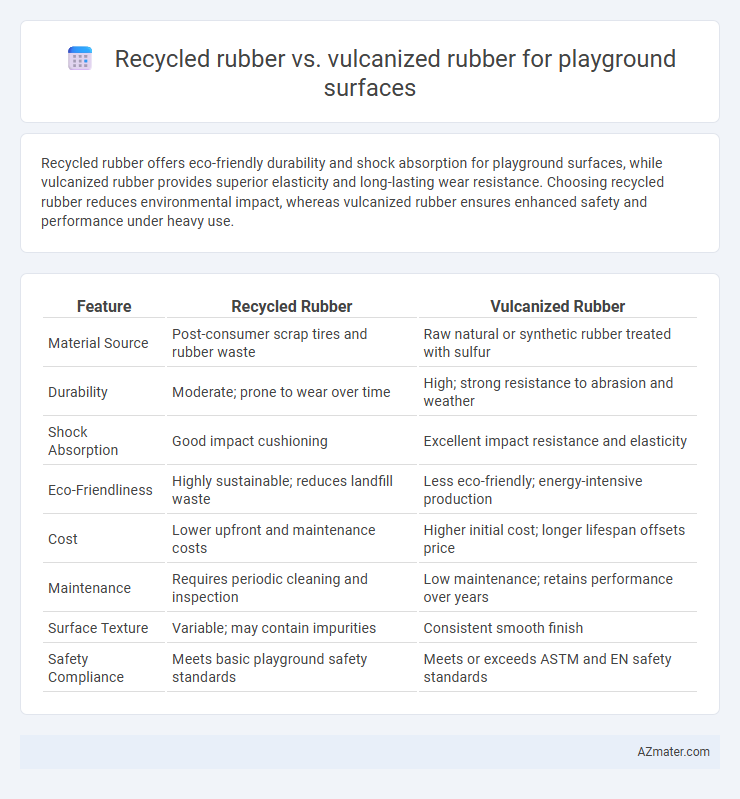Recycled rubber offers eco-friendly durability and shock absorption for playground surfaces, while vulcanized rubber provides superior elasticity and long-lasting wear resistance. Choosing recycled rubber reduces environmental impact, whereas vulcanized rubber ensures enhanced safety and performance under heavy use.
Table of Comparison
| Feature | Recycled Rubber | Vulcanized Rubber |
|---|---|---|
| Material Source | Post-consumer scrap tires and rubber waste | Raw natural or synthetic rubber treated with sulfur |
| Durability | Moderate; prone to wear over time | High; strong resistance to abrasion and weather |
| Shock Absorption | Good impact cushioning | Excellent impact resistance and elasticity |
| Eco-Friendliness | Highly sustainable; reduces landfill waste | Less eco-friendly; energy-intensive production |
| Cost | Lower upfront and maintenance costs | Higher initial cost; longer lifespan offsets price |
| Maintenance | Requires periodic cleaning and inspection | Low maintenance; retains performance over years |
| Surface Texture | Variable; may contain impurities | Consistent smooth finish |
| Safety Compliance | Meets basic playground safety standards | Meets or exceeds ASTM and EN safety standards |
Introduction to Playground Surfacing Materials
Recycled rubber playground surfaces offer sustainable, shock-absorbent, and eco-friendly solutions by repurposing used tires, providing excellent durability and slip resistance. Vulcanized rubber surfaces undergo a chemical curing process that enhances elasticity, strength, and weather resistance, making them ideal for high-traffic playgrounds. Both materials support safety standards by offering impact attenuation and require minimal maintenance, but recycled rubber prioritizes environmental benefits while vulcanized rubber emphasizes performance longevity.
What is Recycled Rubber?
Recycled rubber for playground surfaces is made from repurposed scrap tires and rubber products, offering an eco-friendly alternative to new materials. Its composition provides excellent shock absorption, durability, and slip resistance, which enhances playground safety and comfort. Unlike vulcanized rubber, recycled rubber is cost-effective and supports environmental sustainability by reducing waste.
Understanding Vulcanized Rubber
Vulcanized rubber, created through a chemical process that adds sulfur or other curatives, enhances the durability, elasticity, and heat resistance of raw rubber, making it highly suitable for playground surfaces. This treatment improves the rubber's mechanical properties, providing a safer, more resilient, and weather-resistant surface that withstands heavy foot traffic and extreme temperatures. Compared to recycled rubber, vulcanized rubber offers more consistent performance and longer lifespan, crucial for playground safety and maintenance.
Key Differences: Recycled vs Vulcanized Rubber
Recycled rubber for playground surfaces is primarily made from processed scrap tires, offering cost-effectiveness and eco-friendliness with inherent variability in texture and durability. Vulcanized rubber, created through a chemical curing process that enhances elasticity and strength, provides superior resilience, uniformity, and longevity compared to recycled options. Key differences include vulcanized rubber's enhanced safety performance and consistent quality, while recycled rubber emphasizes sustainability and lower installation costs.
Safety Standards and Impact Absorption
Recycled rubber playground surfaces meet ASTM F1292 safety standards, offering excellent impact absorption that reduces injury risks from falls. Vulcanized rubber, while durable and consistent in structure, provides slightly less shock absorption compared to recycled rubber mixes engineered for playground safety. Emphasis on energy restitution in recycled rubber materials ensures superior compliance with consumer product safety regulations for playground equipment.
Environmental Impact and Sustainability
Recycled rubber playground surfaces significantly reduce landfill waste and lower carbon emissions by repurposing used tires, promoting circular economy principles. Vulcanized rubber, while durable and resilient, often involves energy-intensive manufacturing processes and limited recyclability, impacting environmental sustainability negatively. Choosing recycled rubber enhances eco-friendly playground development by minimizing resource consumption and supporting sustainable waste management practices.
Durability and Maintenance Comparison
Recycled rubber playground surfaces offer moderate durability with resistance to weathering and impact, but may require periodic infill replenishment and cleaning to maintain safety and appearance. Vulcanized rubber provides superior durability due to its cross-linked molecular structure, resulting in enhanced resilience against wear, UV exposure, and temperature fluctuations, which reduces maintenance frequency. Maintenance for recycled rubber is generally more intensive, involving surface repairs and debris removal, while vulcanized rubber surfaces demand less upkeep, making them ideal for high-traffic playground environments.
Cost Analysis: Recycled vs Vulcanized Rubber
Recycled rubber playground surfaces typically offer lower initial installation costs due to the use of shredded or granulated materials derived from waste tires, making them an economical choice for budget-conscious projects. Vulcanized rubber, while more expensive upfront, provides superior durability and longevity, reducing long-term maintenance expenses and replacement frequency. Evaluating total cost of ownership reveals that recycled rubber suits short-term or low-traffic applications, whereas vulcanized rubber delivers better value for heavily used playgrounds requiring resilient, long-lasting surfaces.
Aesthetic and Design Flexibility
Recycled rubber offers a wide range of colors and textures, enhancing the aesthetic appeal of playground surfaces while promoting sustainability. Vulcanized rubber provides greater design flexibility through its customizable hardness and durability, supporting intricate playground layouts and safety features. Both materials enable creative, visually appealing playgrounds, but recycled rubber emphasizes eco-friendly aesthetics, whereas vulcanized rubber prioritizes performance-driven design customization.
Choosing the Best Rubber Surface for Playgrounds
Recycled rubber offers sustainable benefits and excellent shock absorption, making it an eco-friendly choice for playground surfaces that prioritize safety and environmental impact. Vulcanized rubber, characterized by enhanced durability and resistance to weathering due to its sulfur cross-linking process, provides a longer-lasting and low-maintenance option ideal for high-traffic playground areas. Evaluating factors such as budget, environmental goals, maintenance requirements, and playground usage frequency is essential when deciding between recycled and vulcanized rubber surfaces.

Infographic: Recycled rubber vs Vulcanized rubber for Playground surface
 azmater.com
azmater.com